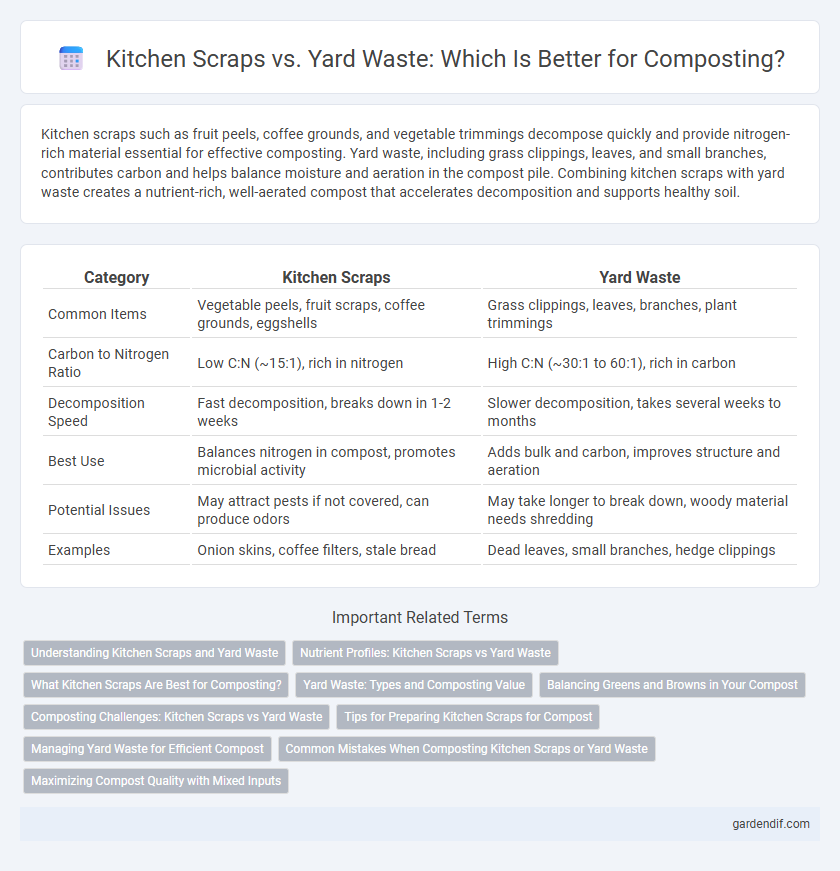
Kitchen Scraps vs Yard Waste Illustration
Kitchen scraps such as fruit peels, coffee grounds, and vegetable trimmings decompose quickly and provide nitrogen-rich material essential for effective composting. Yard waste, including grass clippings, leaves, and small branches, contributes carbon and helps balance moisture and aeration in the compost pile. Combining kitchen scraps with yard waste creates a nutrient-rich, well-aerated compost that accelerates decomposition and supports healthy soil.
Table of Comparison
| Category | Kitchen Scraps | Yard Waste |
|---|---|---|
| Common Items | Vegetable peels, fruit scraps, coffee grounds, eggshells | Grass clippings, leaves, branches, plant trimmings |
| Carbon to Nitrogen Ratio | Low C:N (~15:1), rich in nitrogen | High C:N (~30:1 to 60:1), rich in carbon |
| Decomposition Speed | Fast decomposition, breaks down in 1-2 weeks | Slower decomposition, takes several weeks to months |
| Best Use | Balances nitrogen in compost, promotes microbial activity | Adds bulk and carbon, improves structure and aeration |
| Potential Issues | May attract pests if not covered, can produce odors | May take longer to break down, woody material needs shredding |
| Examples | Onion skins, coffee filters, stale bread | Dead leaves, small branches, hedge clippings |
Understanding Kitchen Scraps and Yard Waste
Kitchen scraps primarily consist of food residues such as fruit and vegetable peels, coffee grounds, eggshells, and small amounts of paper towels, all rich in nitrogen essential for composting. Yard waste includes leaves, grass clippings, branches, and other plant material that provide carbon needed to balance the compost pile. Proper understanding of these materials' carbon-to-nitrogen ratios ensures efficient decomposition and nutrient-rich compost production.
Nutrient Profiles: Kitchen Scraps vs Yard Waste
Kitchen scraps, rich in nitrogen, include fruit and vegetable peels, coffee grounds, and eggshells, providing essential nutrients that accelerate the composting process. Yard waste, often high in carbon, consists of dry leaves, grass clippings, and small branches, balancing the nitrogen by adding structure and promoting aeration in the compost pile. Optimal composting requires a balanced carbon-to-nitrogen ratio, typically around 30:1, to ensure efficient decomposition and nutrient-rich soil amendment.
What Kitchen Scraps Are Best for Composting?
Kitchen scraps best suited for composting include fruit and vegetable peelings, coffee grounds, eggshells, and tea bags, as they are rich in nitrogen and decompose quickly. Avoid adding meat, dairy, and oily foods, which can attract pests and slow down the composting process. Balancing these green materials with carbon-rich browns like leaves or shredded paper helps create nutrient-dense compost.
Yard Waste: Types and Composting Value
Yard waste includes leaves, grass clippings, branches, and garden trimmings, all rich in carbon essential for balanced composting. These materials break down slowly, improving soil structure and aeration while supplying nutrients vital for plant growth. Incorporating diverse yard waste accelerates decomposition, producing nutrient-dense compost that enhances soil fertility and moisture retention.
Balancing Greens and Browns in Your Compost
Kitchen scraps, rich in nitrogen, serve as the "greens" essential for microbial activity in compost, while yard waste like leaves and twigs provide carbon-rich "browns" that help aerate and balance moisture. Achieving an ideal ratio of approximately 30:1 carbon to nitrogen ensures efficient decomposition and minimizes odors. Regularly alternating layers of kitchen scraps and yard waste promotes optimal microbial breakdown and produces nutrient-rich compost for garden use.
Composting Challenges: Kitchen Scraps vs Yard Waste
Kitchen scraps often contain high moisture content and can attract pests and odors during composting, making them challenging to manage without proper balance. Yard waste, while typically low in nitrogen and higher in carbon, can be bulky and slow to decompose, requiring shredding or chopping to speed up the composting process. Balancing the carbon-to-nitrogen ratio is critical to overcoming these challenges and achieving efficient composting of both kitchen scraps and yard waste.
Tips for Preparing Kitchen Scraps for Compost
Cut fruit and vegetable peels into smaller pieces to accelerate decomposition in compost bins. Avoid adding meat, dairy, or oily foods to prevent odors and pests during composting. Maintain a balanced mix by combining nitrogen-rich kitchen scraps with carbon-rich yard waste for optimal microbial activity.
Managing Yard Waste for Efficient Compost
Managing yard waste efficiently enhances compost quality by balancing carbon-rich materials like dry leaves, grass clippings, and wood chips with nitrogen-rich kitchen scraps. Properly shredding and layering yard waste accelerates decomposition, prevents clumping, and maintains optimal aeration in the compost pile. Regular turning of the compost pile ensures even breakdown of yard waste, minimizing odor and maximizing nutrient-rich humus production.
Common Mistakes When Composting Kitchen Scraps or Yard Waste
Common mistakes when composting kitchen scraps include adding meat, dairy, or oily foods, which can attract pests and create odors. Yard waste errors often involve composting large woody branches or diseased plants that decompose slowly or spread pathogens. Balancing nitrogen-rich kitchen scraps with carbon-heavy yard waste is crucial to maintain optimal microbial activity and effective composting.
Maximizing Compost Quality with Mixed Inputs
Combining kitchen scraps rich in nitrogen with carbon-rich yard waste enhances microbial activity essential for high-quality compost. Proper ratios of green and brown materials balance moisture and aeration, accelerating decomposition and producing nutrient-dense humus. Mixing diverse organic inputs ensures optimal carbon-to-nitrogen levels, resulting in improved soil fertility and structure.
Kitchen Scraps vs Yard Waste Infographic

 gardendif.com
gardendif.com